Bobbin Banga: A Love for Artful Design and Precision Machinery



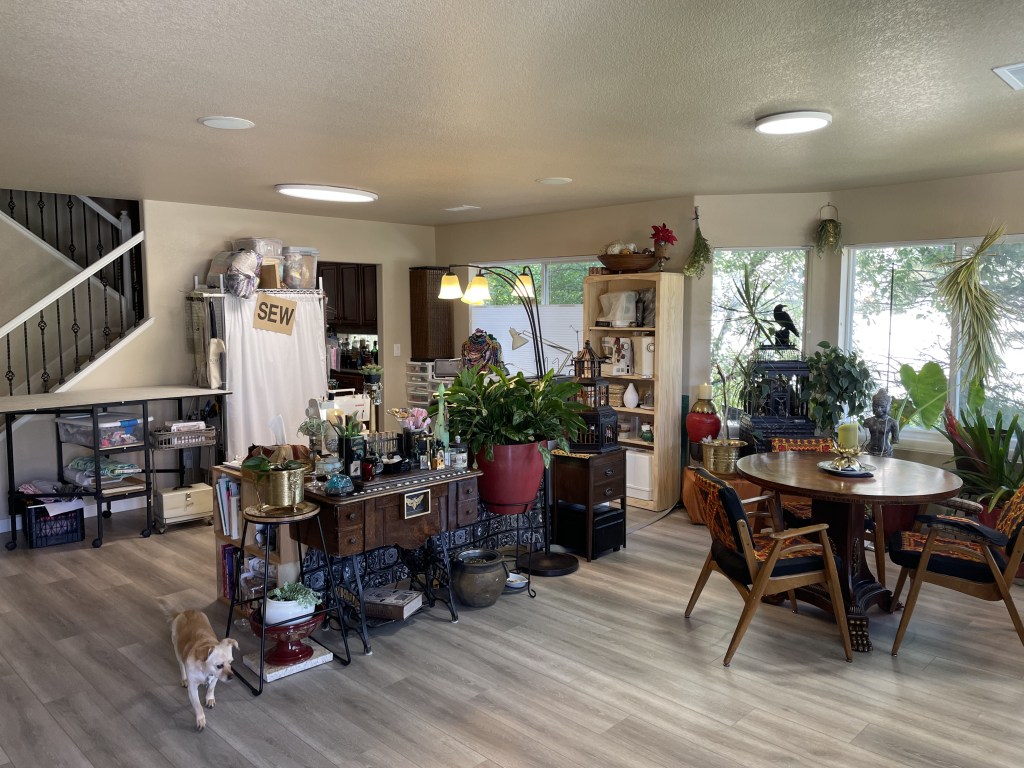
One Year Into a New Home and Sewing Room/Maker’s Lab
It is now August 2022. I’ve had the incredible fortune of finding an extraordinary partner, and we’ve merged our lives after years of long-distance to create a home together. My new sewing room has expanded to become a full-on “Maker’s Lab,” because I do so much more than sewing. My first project in the new home was to upholster vintage teak chairs for this sitting room. The fabric was harvested with care and precision from an antique Indian duvet.
I’ve not solved my storage issues for the sewing supplies just yet, so please don’t mind the temporary arrangement and clutter too much. This is an in-progress shot of the room as I research cabinetry and shelving. I still need a moment to make informed decisions about how much DIY/customized construction I can reasonably manage. Encouragingly, the sunlight, plants, and spaciousness have me feeling grateful and eager to settle the space with a clean and streamlined storage design. Your suggestions are welcomed!
My “old” and Well-used Sewing Space

My Dream Sewing Room… located in the unfinished basement, but filled with maximum creative juice for a fraction of the price (courtesy of tag sales, Habitat for Humanity, and area thrift stores). Only one machine is new. All other machines were found second-hand. I know it looks like a dated and goofy space, but I love it! Nothing matches, but everything works just fine.
- Foundation machines always ready on the table. Collectibles and vintage ecoutraments kept nearby.
- This large drafting table was fashioned by putting two reclaimed hotel desks back to back ($60 total from Habitate for Humanity). A vintage treadle (complete with a bullet bobbin), turn of the century mechanical, and Juki industrial machine complete the dream space..
- Yes… OCD runs in my family and I too am stricken with the craving for clarity and organization. This used $60 wall unit does the job nicely.
- A corner lounge for hand-work, design review, and new inspirations. Adorned with vintage kimonos, skirts and caftans found during my travels
- My unfinished, bargained, basement sewing room. Nothing matches, and everything is second-hand with the exception of one machine. It may not be fancy, but I love it. Yes, that is a self-made, duct tape dress form on a PVC pipe stand (supplies $25). Wonderfully customized and easily updated as life archives itself on in my maturing body!
- My elderly rescue dogs chilling in my sewing room with me. My Italian greyhound roasts herself in front of a space heater while my Chi hua hua paws impatiently at my legs during delicate stitching of seams.
- Notions stored in a vintage fishing tackle box that was only $4.00
- My Creole Grandmother’s embroidery and sewing notions kept in a curio cabinet for perpetual inspiration.
- Presser foot fanatic. Guilty!
- All notions, tools, fabrics, and materials organized to be easily located the moment inspiration strikes.
- 2017 updates: new fabric organization, a filing cabinet for patterns, and all drafting tools organized for easy access.
- Every maker’s space needs a tribute to Frida Khalo!
- My daughter and I sit across from each other chatting, snacking and singing to jams as we sew. Her young impatience with sewing has matured into the calm, concentrated demeanor of a skilled artisan. How wonderful to be able to share this space with her.
- The 2017 version of the sewing room after reorganizing and making space for my daughter to join me. She saved up and bought her own Babylock Sophia, and has become an amazing talent in quilting and crafting.
Oh my… I’m outing myself as a sewing addict. Actually, my unending love for it goes far beyond machine sewing; I adore all needle crafting, weaving, fiber arts and machine restoration. Back in 2001, I grew thoroughly demoralized shopping for clothing with my post-pregnancy-still-in-transformation-body. My friendship with award-winning designer Gypsy Ames (Faculty member at Colorado College) inspired me to aim for some self-sufficiency, and admittedly I’d spent most of my childhood sketching fantastical costume and human figure studies. With feisty defiance decided I would learn to make my own clothing before my self-esteem caved in much further. I didn’t have anyone to teach me, but I figured that shouldn’t stop me. I was on a mission. For all you folks with curves, I know you’re feeling me here…
Although ignorant of my good fortune at the time, I scored a used mechanical Bernina 1008 for $450 (massive score, no?), and an old White overlock machine for $150, then set off to make fabulous stuff! I soon learned that drafting, patterning, altering, and machine management involved much more research, education and investment than I was prepared for as a busy new mom. But through small projects and increments of time, I found my way forward into the craft. My infant was too curious to play quietly while I fumbled through my sewing, so most of my early efforts were late at night after she was asleep. Frequently I didn’t have the energy to tackle a large project, so instead I would take 30 minutes to practice things such as making buttonholes, inserting zippers, and learning the cause/effect of different stitch patterns on fabric. I prowled the thrift stores for vintage sewing books and picked up a few collector machines during my adventures. I had very little time to sew, but I sure did love my time with the machines when I could get it.
When Craftsy.com launched in 2011, I jumped on board to learn all the wonderful little things I couldn’t seem to figure out from illustrations in literature. The acquisition of knowledge set me free to fully indulge my creativity, and I haven’t bumped into boredom yet. I finished graduate school in 2012, and relocated to a home with a large unfinished basement to set up my fantasy sewing room. Do I feel lucky? Oh yes. I have a dream space and absolutely everything in it was thrifted and acquired second-hand: furniture, machines, remnants, tools, etc. My Louisiana-born grandmother was an embroidery artist, and her vintage tools are the crowning jewel hung in a wall case for inspiration.
Having something other than dance has become crucial to my creative flow in life and career. The benefit of detailed, fine motor movement with my hands, contemplative time, blossoming patience and attention to detail have made me a better dancer/artist/scholar/writer/etc. By becoming self-sufficient in my garment-making, I grew curious about other ways to unplug from the mega-monolith commercial machine of my urban upbringing–I explored canning, home cooking, dehydrating, family gardening (not my strongest skill, I murder many plants), and crafting a homespun life on as many levels as possible. So all of you bloggers who have shared your journeys with me, I THANK you for the inspiration. My elders were not around to guide me in my explorations, and I have relied on you more than you know.
I have grown to deeply appreciate the creativity and craft so many women and men have put into the seemingly task-oriented construction of garments. I don’t consider myself a true fashionista (tangent warning: I’m too addicted to knit fabrics and pajama-like comfort. Heaven knows I can’t bear to wear heels! Plus I’m a fan of androgyny. Gender is so over isn’t it? I’m not femme enough for couture in my opinion), but I do experience deep awe for refined construction and creative design on any scale… whether in a couture dress, curtains or a hand-sewn apron. And I deeply appreciate the efficient and loving work of my ancestral women who constructed clothing for their entire families.
My fondness for mechanical machines (versus computerized models) ensures an abundance of choices at the thrift stores. Everyone seems to be abandoning mechanical models in favor of machines that have lazer seam guides, digital embroidery and a host of automated features. I completely understand that appeal and have no criticism of that preference at all. Someday I look forward to the indulgence of a computerized machine. I can only offer that for now something in me is fed by the attentive and refined practice of tuning myself to the workings of my mechanical machines. Admittedly, I have become a collector and epic enthusiast. I have a particular affinity for restoring knowledge and craftsmanship we’ve discarded in favor of convenience and technology. I endeavor to understand the science behind well-drafted work, and thoroughly enjoy whatever problem solving that effort presents on a mechanical machine. Fortunately, there is very little grief in my sewing these days, because my collection of steel-motor vintage machines (see Geeky “Honey” gallery below) run like buttah and are tremendously sturdy. Many current home machines on the market are simply not made to be operative for 100 years with their nylon gear parts. So if you see a vintage machine during your antique or thrift store adventures, it’s worth checking out.
SO… I hereby consecrate this little corner of my website to serve as my digital altar to all things fiber, design, needle and sewing related. Concurrent to my sewing addiction, I’ll be sharing my adventures in learning tatting, crochet, lace-making, and weaving. I make no apology for my addictions, and if I last long enough to retire my dancing body, you can bet I’ll be found most days in my funky, freaky little sewing room having a good old time, bumping good music and probably talking to myself joyfully.
DONNA’S NO-SHAME-NERD-OUT MACHINE GALLERY






















SMILED UPON BY THE SAINTS OF SEWING
While ambling through Habitat for Humanity’s Restore during December of 2013 with a friend, I stumbled upon a special treasure: a vintage singer sewing machine. There are plenty to be found on the internet, and as a sewing enthusiast I’d send out occasional tentacles looking for one to bid on. This particular day, I was thrilled to find a 1950 electronic model in great shape along with its original desk-bed. I was unable to test the machine fully before making the purchase, but knew that $170 was a fair deal for this lovely antique.
Caught up in my busy life, it was a few days before I sat down to fully assess its operative functionalism, and enjoy a leisurely tour of the machine. The desk was beautifully solid. The machine was impeccably clean and still produced a quality stitch. So far, so good. Much to my delight the desk drawers contained boxes of undisclosed items. I prepped a warm cup of my favorite tea and sat down to explore.
In the drawers was a fully complete set of accessories, attachments, antique accoutrements (nail file, bobbins, vintage buttons, scissors, fabric and lace remnants, tailor’s awl, etc.) and flawlessly preserved instructional booklets for all mechanical items. The caliber of fastidious care and organization was counterbalanced by the presence of creative project seeds: miniature dove figurines placed in a Sucrets lozenger tin with colorful sequins and coordinating buttons; a homemade pin cushion embroidered with the image of a benevolent smiling sun. The sweetness of each memento portrayed a sewing artist who cared deeply about what was produced, and each tin box of treasures communicated appreciation and preciousness.
I slowed down my explorations to absorb fully. I moved beyond my initial “JACKPOT” buzz to reverently regard the inherent elegance of the collection’s organization. This time capsule provided several hours of magical thinking and slow, deep breathing. I could nearly sense the previous owner’s gentle smile blasting through each item while turning it over in my hands. Surely this was not given away thoughtlessly. The entire assemblage was so under-priced and I could only surmise some uninformed youngster had donated the items after failing to rid them through an estate sale. I was charmed, flush with gratitude, and amazed at my good fortune. I was now guardian of this pristine collection and I wanted to do right by the owner.
I didn’t know his or her name. I didn’t know how the collection ended up discarded at a thrift store when it clearly could have garnered big bucks at a collectors’ auction. I didn’t know why the Saints of Sewing smiled on me that day. If nothing else I can share that my romantic imaginings made for a lively afternoon. But truthfully something larger was conveyed through this acquisition. My private backstage pass to this sewer’s deep passion revitalized me and inspired me to sew. More than that, I was also compelled to share with you that I witnessed evidence of someone who cared passionately about the craft. So much so that they brought me to tears in their absence.
Apparently the previous owner didn’t have any initiates to pass that sewing dowry to within their proximal environment. In a passing moment I couldn’t help but wonder if the owner would/would not have approved of me, specifically, taking ownership of their treasure. The time stamp and breath of the collection could easily be attributed to an elder born of a conservative generation and income bracket that might not favor sharing this treasure with a very progressive multi-ethnic woman with a nose ring and dreadlocks. I hate that the thought ever crossed my mind, but it did (undoubtedly an after-effect of always being the ONLY woman of color at sewing expos and classes).
Not having full information, I let go of that line of conjecture. I deliberately chose to view the change of ownership as something of a cosmic balancing.
I therefore wish to offer tribute to an unknown adept in my craft. If relinquishing this collection was an action of abandonment or born of exasperation, I am here to unequivocally say that thoughtfulness, distinction and rich imagination reads in every piece of what was bestowed. Whoever you are, I offer my compliments. I am only working with puzzle pieces of an identity, but the clues left behind read so clearly of excellence.
Yes, I know I’m making way too much of this purchase. In my defense I can only ask if you’ve ever encountered an object of art, a song, a book, or anything that aroused your curiosity to learn the human story behind the item? I like that in life. In fact, I love being moved to think and imagine beyond the ordinary. Dignifying the efforts of the previous owner felt important to me because the collection was imbued with something larger than pure function. It was drenched in love.
With these words, I send a blast of gratitude out for what has transpired. I will honor and enjoy the tools that have absorbed such tangible renderings of human beauty. I will create my own beauty with them on your behalf, whoever you are. I will remember that excellence matters, and that I matter… even if my name is lost in the shuffle over the ages. Thank you for who you are–or were. Your meticulous magic has left a permanent impression and the heart of an artist shines through what you left behind. You can trust me to exercise the same care with your beloved sewing collection. Across whatever time and distance separates us, you are appreciated.
- The full time capsule sewing collection.
- Inside the sitting bench, a collection of trims, scraps, lace edgings, etc.
- All variety of attachment feet, including multiple zipper choices, pintuck feet, rufflers, and rolled hemmers.
- A vintage button hole attachment with 9 templates for button sizing.
- Vintage blind stitch attachment
- Vintage zig zag attachment
- Vintage Sucrets tin filled with fine needles, bobbins, thimbles and a locket key.
- More vintage tins with treasures inside… no rust, no mess… everything well cared for.
- More tins and boxed filled with buttons and beads, and organized by themes and textures.
- Lovely wooden spools of thread that make me smile.
- The full collection of thread from the time capsule.
- A hand embroidered pin cushion with a radiant sun emblem.
- Original tools, bulbs, needles and lubricants sold with the machine.
- All the magical accoutrements of fine sewing: seam guages, awls, hand needles, tape measure, chalk, etc.
- Pristine and unmarked instructional booklets for the machine and all accompanying attachments in both French and English.
THE SOUL DREAMS OF HOME
As I write this, Colorado is in the full bloom of spring. As summer break begins, I switch mental gears from being a performer and move gleefully into the land of homesteading: gardening, house projects, animal care (family dogs, yard birds and bunnies) and cooking the wonderful seasonal foods. I travel frequently, so time at home has become the foundation of my personal balance in between touring engagements. I have filled my home space with the generous, heart-filled mementos from friends and fans (thank you!). I’ve also become addicted to antique shopping during my travels. Ultimately, these fascinations culminated in the installation of little “gratitude” shrines in every conceivable nook and corner of my abode. Here are a few glances!



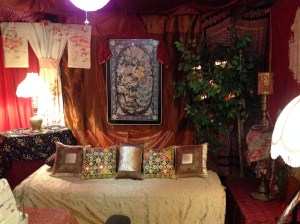
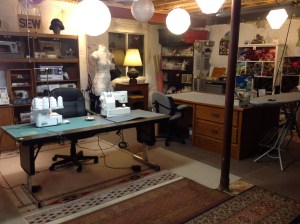

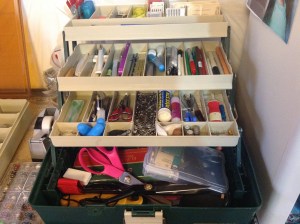
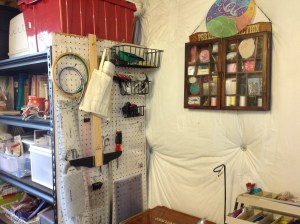
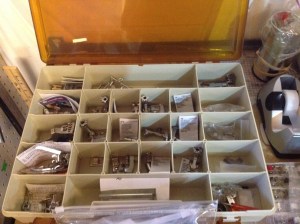

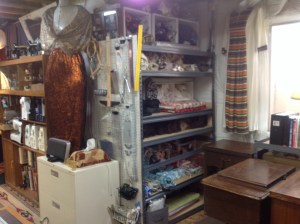
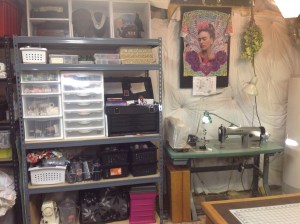
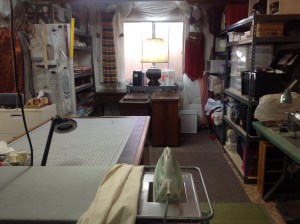

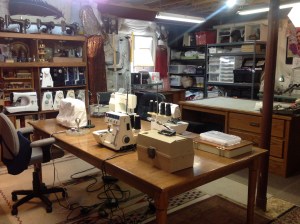





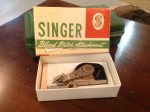


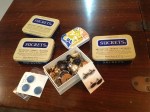
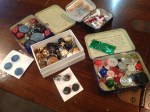
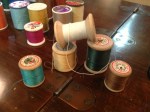
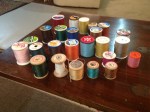
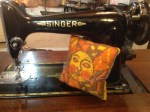
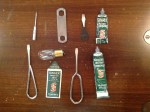





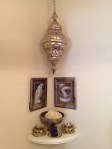


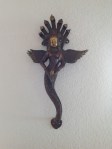

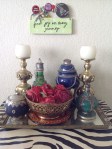
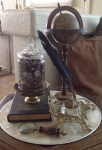


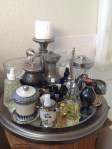
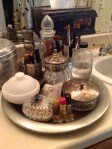

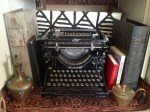
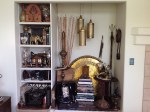
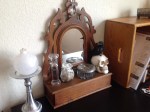





I found inspiration through your crafting post. I’ve been afraid to explore the basement of our new home and have now found one way in thank you. Love it when a prayer gets answered.
I’m amazed at your hand-crafted dress form! As a fellow belly dancer & sewer I would like to design and sew more of my costume pieces. A dress form would be so helpful, but new ones are too expensive. Would you mind sharing how you created your dress form? Thanks!
Hello Barbara, I have a vintage video from the 1980’s providing instructions for a duct-tape dress form. However, I found a good summary here for you: http://so-sew-easy.com/diy-duct-tape-dress-form/. Once you’ve had a friend create multiple layers of duct tape over thin, cotton long underwear, simply snip an opening from the neck to the bum and slide yourself out. I filled mine with recycled plastic grocery bags and placed it on a PVC T-Bar (screwed into a lazy-susan base). Enjoy!
This is so beautiful and wonderful and inspiring. I too honor and respect the mechanical precision machines, and am blown away by your collection. I wish you much happy sewing and recollecting in your wonderful space. That you for brightening my day with your pictures and words.
Pingback: Adoring Donna Mejia | askmissbellydance
Pingback: Behind the Curtain with Donna Mejia – Everyday Tribal.